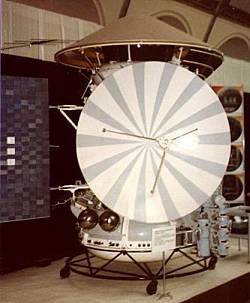Forty years ago today — August 5, 1973 — the Soviet Union launched their third of four 1973 missions to Mars from the Baikonur Cosmodrome on a Proton K rocket.

(Mars 6. Image from the National Space Science Data Center.)
The Mars 6 “interplanetary station” featured a descent module that separated from the spacecraft bus to enter the Martian atmosphere. The bus continued on a flyby, while transmitting back telemetry.
The first pair of the USSR’s 1973 Mars spacecraft had launched in July, and reached Mars in February 1974. Mars 6 arrived at Mars on March 12, 1974.
The descent module separated from the bus at a distance of 48,000 km from Mars. The bus continued on into a heliocentric orbit after passing within 1600 km of Mars. The descent module entered the atmosphere at 09:05:53 UT at a speed of 5.6 km/s. The parachute opened at 09:08:32 UT after the module had slowed its speed to 600 m/s by aerobraking. During this time the craft was collecting data and transmitting it directly to the bus for immediate relay to Earth. Contact with the descent module was lost at 09:11:05 UT in “direct proximity to the surface”, probably either when the retrorockets fired or when it hit the surface at an estimated 61 m/s. Mars 6 landed at 23.90 S, 19.42 W in the Margaritifer Sinus region of Mars.
Mars 6 was the first spacecraft to send back data from Mars, though its lifespan was very short as indicated above. It sent back a little under 4 minutes’ worth of data (224 seconds, to be exact).
Unfortunately, much of the data were unreadable due to a flaw in a computer chip which led to degradation of the system during its journey to Mars.








Pingback: Mars 7′s Ill-Fated Voyage, Plus One - Ghost Writer